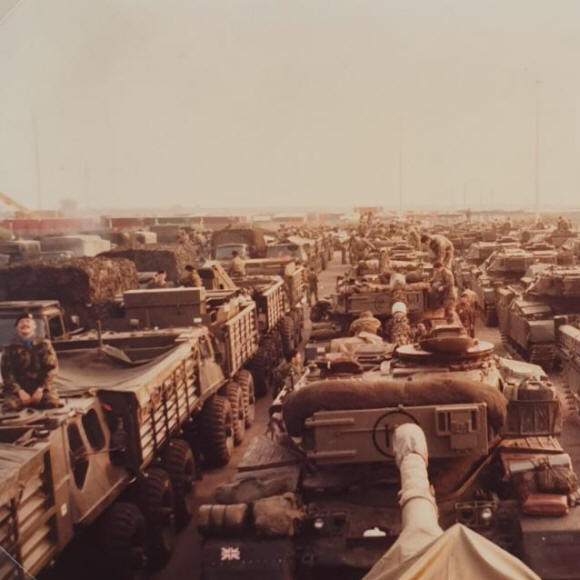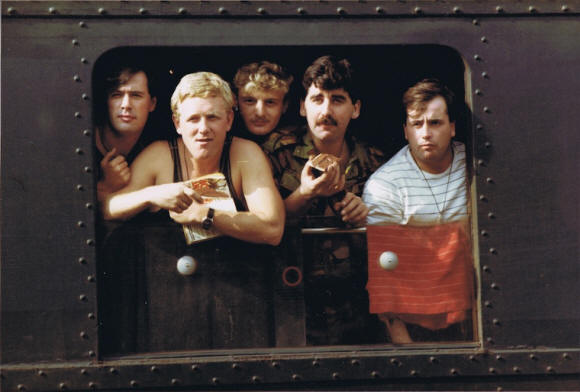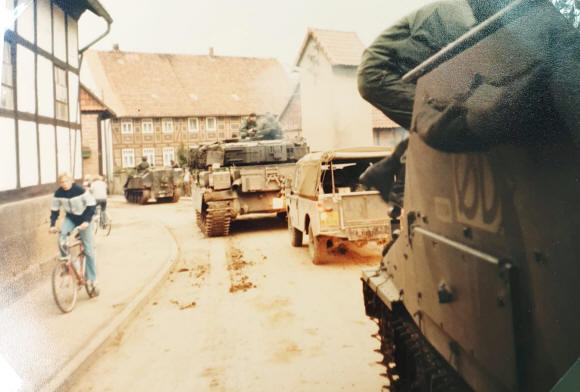|

DURING MY
MILITARY CAREER I was involved in two major military
operations; the biggest by far was the First Gulf War
1990-91, of which more later. The other was Exercise
Lionheart in 1984, which was also quite staggering in
scale.
Lionheart was a test and demonstration of 1 (Br) Corps
ability to deploy and meet a massed Soviet attack across
the Inner German Border (IGB) during the Cold War, and
involved some 131,000 British troops including
Territorial Army and Reservists from Germany and the UK
and took place over 3,700 square miles in Belgium, the
Netherlands and (the then) West Germany. A further 3,500
Dutch, 6,300 German, 3,400 US and 165 Commonwealth
soldiers also took part as enemy and umpires amongst
other functions. It was a huge effort.
The #BARITWE[1] was still stationed at Tidworth on
Salisbury Plain as part of 19th Infantry Brigade, which
itself was part of the 3rd UK Armoured Division on
deployment. The exercise comprised two main parts;
Exercise Full Flow, which practiced the deployment of UK
based elements across the Channel to Ostend or Zeebrugge
and then into position alongside Germany based elements,
followed by the combat training bit which was called
Exercise Spearpoint.

Lionheart train party at the ready
In some
ways the deployment part was the most interesting for
us. Our panzers went by road (transporter I assume) to
the little known military port of Marchwood near
Southampton, there to be loaded on to one or other of
the Royal Fleet Auxiliaries (RFAs) and shipped over to
Zeebrugge. Of this move I know nothing as I went with
the road party, travelling in CO Hedley Duncan’s Land
Rover (photo of Hedley below) as I was then Ops Officer.
I think we went by civvy ferry to Ostend.

CO Headley Duncan
Upon
arrival we disembarked and then were directed to a
section of the Belgian motorway system, which had been
blocked off to civvy traffic to allow us to form up into
packets for the journey into West Germany. Here we were
marshalled by the RMP and Belgian police into “packets”
of vehicles and eventually sent on our way along the
motorway system towards the German border. Thousands of
vehicles proceeded at a maddeningly slow pace – 40 km in
the hour or something like that – all day and all night.
Once inside Germany (West), we entered a replen area. In
real conflict we would have, of course, deployed upon
multiple routes via numerous replen stops but such
arrangements in peacetime would have been overly
disruptive. Be that as it may, our replen area provided
fuel for the vehicles, a chance for a wash and shave,
and a hot meal. It was run by one of the Royal Irish
Ranger battalions, and faced with the challenge of
feeding the thousands arriving around the clock, had
made the very sensible decision to provide one menu
only, in vast quantities, 24 hours a day. So, for
breakfast, lunch, and dinner the choice was… yep, Irish
stew. And very good it was too.
I can’t remember the details of where and when we
married up with our panzers, but we then deployed into
“hides” as we would have done for real. 4RTR battlegroup
at this point consisted of RHQ, C Squadron, G Squadron,
and a mechanised infantry company from 1 Staffords,
having “exported” our other squadrons to other
battlegroups within 19 Infantry Brigade, our parent
formation initially. In RHQ we established ourselves
right in the middle of a typically neat German rural
town (photo below), hiding our vehicles away in barns
and farmyards occupied by the local population who
didn’t seem at all fazed by our invasion into their
privacy. C Squadron leader, Major Tom Brown US Army (on
attachment), chose to take his tanks into a wood a few
kilometres away, probably to get as far away from RHQ as
possible!

Lionheart moving into hide
Having
settled in, cammed up, and established our routine, we
waited, a not unusual occurrence in military manoeuvres.
I think we waited for a week at least with not much
happening. Then the “enemy” started probing, and I have
recollections of being unable to get permission from
Brigade to engage because they couldn’t get authority
from Division, a grim reminder of the lack of confidence
and inability to react quickly that has plagued the
British army since time immemorial. Finally, I awoke in
the middle of the night to find we had been over-run by
the Americans and, having woken up the CO, we buggered
out Hell-for-leather towards the rear. Not a very
auspicious beginning to our exercise.
This was Phase One of the exercise, defending against
the enemy attack. Phase Two was, as ever, the counter
attack and drive to final victory. At some point we got
our other two tank squadrons back, crossed the River
Leine (thank goodness the CO and I had done a recce the
night before otherwise we would never have found the
crossing point!) and advanced to Sibbesse where we were
regrouped into 20 Armoured Brigade for the final part of
the exercise. One of the more interesting parts of
proceedings was casualty evacuation procedures, which we
practised for real. Inevitably some of our tanks broke
down, and others were designated casualties by the
exercise umpires. These were then recovered by standard
operation procedures, but we didn’t see the crews again
for weeks and some of the panzers were returned to us
months later!
Of our return to the UK I can recall very little, except
that bizarrely we staged through our old barracks at
York Kaserne in Munster, now occupied by the Queen’s
Royal Irish Hussars (QRIH). They were, how shall I put
it, grudgingly hospitable towards us, and put a brave
face on hosting their clearly unwelcome guests. Compare
and contrast with the wonderful
Seventeen-Slash-Two-One-Ell (17/21st Lancers) who were
still just down the road where we had left them when we
moved to the UK. I went down to see my old chums and was
immediately invited to one of their formal Officers’
Mess dinner nights. I protested that I had only had my
combat kit to wear but was told that was immaterial.
Accordingly I found myself their guest, my hosts in
their very fine mess kit, silver on the table and
regimental band playing through dinner, with me in my
combats. There’s the mark of a professional and
confident regiment!
After a few days we were on our way, and this time I
came back with the CO’s party together with some of our
tanks on one of the Royal Fleet Auxiliaries, possibly
Sir Bedivere or one of its ilk. On our way across the
Channel it blew up a Force 9 gale, which is pretty rough
actually, and we were forced to hold off from docking at
Marchwood until the storm passed. Luckily for us, a nip
of gin in the officers’ wardroom was 2p at the time, and
I don’t think any of us were bothered by the weather at
all! The next day we docked and were soon back in
Bhurtpore Barracks in Tidworth, with most of the rest of
the Regiment rejoining us in the next couple of days.
And that was it, probably the biggest peacetime exercise
the British army undertook in recent memory. There was
no hanging about, though, for 4th Tonks was coming to
the end of its UK sojourn and was due to head back to
West Germany, exchanging barracks with the 5th
Inniskilling Dragoon Guards in Osnabruck, not far from
our previous home in Munster. I suspect most of the boys
were happy to return to Germany where the pay was better
and the standard of living probably higher at that time.
Many of us found life in an English garrison town a tad
monotonous and were glad when it came to an end.
I, however, did not return overseas with the Regiment,
as I had passed the Staff College exams and was selected
to start that two year episode almost immediately. I was
not to return to 4th Tonks, apart from a couple of short
visits, for another four years.
To come in Part 15; Staff College and MoD job.
© Stuart Crawford 2020
[1] Best Armoured Regiment In The World Ever
Ostend and
Zeebrugge
April 23: May 10, 1918 Despaches of Vice-Admiral Sir
Roger Keys, K.C.B., K.C.V.O. and other Narratives of the
Operations edited by C. Sanford Terry, Litt.D. (1919)
(pdf) |
